 Artificial Intelligence (AI) is transforming the way we live and work, with many of us knowingly or unknowingly using some form of AI daily. Businesses are also adopting AI in increasingly innovative ways. One example of this is the use of pricing algorithms, which use large datasets on market conditions to set prices.
Artificial Intelligence (AI) is transforming the way we live and work, with many of us knowingly or unknowingly using some form of AI daily. Businesses are also adopting AI in increasingly innovative ways. One example of this is the use of pricing algorithms, which use large datasets on market conditions to set prices.
While these tools can drive innovation and efficiency, they can also raise significant competition concerns. Subsequently, competition authorities around the world are dedicating efforts to understanding how businesses are using AI and, importantly, the potential risks its use may pose to competition.
How AI pricing tools can enhance competition
The use of AI pricing tools offers some clear potential efficiencies for firms, with the potential to reduce costs that can potentially translate into lower prices for consumers.
Take, for instance, industries with highly fluctuating demand, such as airlines or hotels. Algorithms can enable businesses to monitor demand and supply in real time and respond more quickly, which could help firms to respond more effectively to changing consumer preferences. Similarly, in industries which have extensive product ranges, like supermarkets, algorithms can significantly reduce costs and save resources that are usually required to manage pricing strategies across a large range of products.
Furthermore, as pricing algorithms can monitor competitors’ prices, firms can more quickly respond to their rivals. This could promote competition by helping prices to reach the competitive level more quickly, to the benefit of consumers.
How AI pricing tools can undermine competition
 However, some of the very features that make algorithms effective can also facilitate anti-competitive behaviour that can harm consumers. In economic terms, collusion occurs when firms co-ordinate their actions to reduce competition, often leading to higher prices. This can happen both explicitly or implicitly. Explicit collusion, commonly referred to as illegal cartels, involves firms agreeing to co-ordinate their prices instead of competing. On the other hand, tacit collusion occurs when firms’ pricing strategies are aligned without a formal agreement.
However, some of the very features that make algorithms effective can also facilitate anti-competitive behaviour that can harm consumers. In economic terms, collusion occurs when firms co-ordinate their actions to reduce competition, often leading to higher prices. This can happen both explicitly or implicitly. Explicit collusion, commonly referred to as illegal cartels, involves firms agreeing to co-ordinate their prices instead of competing. On the other hand, tacit collusion occurs when firms’ pricing strategies are aligned without a formal agreement.
The ability for these algorithms to monitor competitors’ prices and react to changes quickly could work to facilitate collusion, by learning to avoid price wars to maximise long-term profits. This could result in harm to consumers through sustained higher prices.
 Furthermore, there may be additional risks if competitors use the same algorithmic software to set prices. This can facilitate the sharing of confidential information (such as pricing strategies) and, as the algorithms may be able to predict the response of their competitors, can facilitate co-ordination to achieve higher prices to the detriment of consumers.
Furthermore, there may be additional risks if competitors use the same algorithmic software to set prices. This can facilitate the sharing of confidential information (such as pricing strategies) and, as the algorithms may be able to predict the response of their competitors, can facilitate co-ordination to achieve higher prices to the detriment of consumers.
This situation may resemble what is known as a ‘hub and spoke’ cartel, in which competing firms (the ‘spokes’) use the assistance of another firm at a different level of the supply chain (e.g. a buyer or supplier that acts as a ‘hub’) to help them co-ordinate their actions. In this case, a shared artificial pricing tool can act as the ‘hub’ to enable co-ordination amongst the firms, even without any direct communication between the firms.
In 2015 the CMA investigated a cartel involving two companies, Trod Limited and GB Eye Limited, which were selling posters and frames through Amazon (see linked CMA Press release below). These firms used pricing algorithms, similar to those described above, to monitor and adjust their prices, ensuring that neither undercut the other. In this case, there was also an explicit agreement between the two firms to carry out this strategy.
What does this mean for competition policy?
Detecting collusion has always been a significant challenge for the competition authorities, especially when no formal agreement exists between firms. The adoption of algorithmic pricing adds another layer of complexity to detection of cartels and could raise questions about accountability when algorithms inadvertently facilitate collusion.
 In the posters and frames case, the CMA was able to act because one of the firms involved reported the cartel itself. Authorities like the CMA depend heavily on the firms involved to ‘whistle blow’ and report cartel involvement. They incentivise firms to do this through leniency policies that can offer firms reduced penalties or even complete immunity if they provide evidence and co-operate with the investigation. For example, GB eye reported the cartel to the CMA and therefore, under the CMA’s leniency policy, was not fined.
In the posters and frames case, the CMA was able to act because one of the firms involved reported the cartel itself. Authorities like the CMA depend heavily on the firms involved to ‘whistle blow’ and report cartel involvement. They incentivise firms to do this through leniency policies that can offer firms reduced penalties or even complete immunity if they provide evidence and co-operate with the investigation. For example, GB eye reported the cartel to the CMA and therefore, under the CMA’s leniency policy, was not fined.
But it’s not all doom and gloom for competition authorities. Developments in Artificial Intelligence could also open doors to improved detection tools, which may have come a long way since the discussion in a blog on this topic several years ago. Competition Authorities around the world are working diligently to expand their understanding of AI and develop effective regulations for these rapidly evolving markets.
Articles
Questions
- In what types of markets might it be more likely that artificial intelligence can facilitate collusion?
- How could AI pricing tools impact the factors that make collusion more or less sustainable in a market?
- What can competition authorities do to prevent AI-assisted collusion taking place?
 The UK Competition and Markets Authority (CMA) has been investigating road fuel pricing in the UK. In July 2022, it launched a study into the development of the road-fuel market over recent years. The final report of this study was published in July 2023 and covered the refining, wholesale and retail elements of the market.
The UK Competition and Markets Authority (CMA) has been investigating road fuel pricing in the UK. In July 2022, it launched a study into the development of the road-fuel market over recent years. The final report of this study was published in July 2023 and covered the refining, wholesale and retail elements of the market.
In the retail part of the market, the CMA noted some potential causes for concern: retailer fuel margins had increased; there were geographical variations in pricing; filling stations with fewer competitors tended to charge higher prices; retail prices tended to rise rapidly when oil prices increased but fell slowly when oil prices fell (known as ‘rocket and feather’ pricing patterns); motorway service stations charged considerably higher prices than supermarkets or other filling stations.
In response to these findings, the CMA has been publishing an interim report every four months. These reports give average pump prices and margins. They also give relative average pump prices between different types of retailer, and between each of the supermarkets.
The latest interim report was published on 26 July 2024. It reiterated the finding of the 2023 report that the fuel market has become less competitive since 2019. What is more, it continues to be so. In particular, the range of retail prices and the level of retail margins remain high compared to historic levels. The interim report estimates that ‘the increase in retailers’ fuel margins compared to 2019 resulted in increased fuel costs for drivers in 2023 of over £1.6bn’.
Price leadership
 Road fuel retailing is an oligopoly, with the major companies being the big supermarkets, the retail arms of oil companies (such as Shell, BP, Esso and Texaco, operating their own filling stations) and a few large specialist companies, such as the Motor Fuel Group (MFG), the EG Group and Rontec, whose filling stations sell one or other of the main brands. But although it is an oligopoly producing a homogeneous product, it is not a cartel (unlike OPEC). Nevertheless, there has been a high degree of tacit collusion in the market with price competition limited to certain rules of behaviour in particular locations. A familiar one is setting prices ending in .9 of a penny (e.g. 142.9p), with the acceptance by competitors that Applegreen will set it ending at .8 of a penny and Asda at .7 of a penny.
Road fuel retailing is an oligopoly, with the major companies being the big supermarkets, the retail arms of oil companies (such as Shell, BP, Esso and Texaco, operating their own filling stations) and a few large specialist companies, such as the Motor Fuel Group (MFG), the EG Group and Rontec, whose filling stations sell one or other of the main brands. But although it is an oligopoly producing a homogeneous product, it is not a cartel (unlike OPEC). Nevertheless, there has been a high degree of tacit collusion in the market with price competition limited to certain rules of behaviour in particular locations. A familiar one is setting prices ending in .9 of a penny (e.g. 142.9p), with the acceptance by competitors that Applegreen will set it ending at .8 of a penny and Asda at .7 of a penny.
One of the main forms of tacit collusion in areas where there are several filling stations is that of price leadership. Asda, and in some areas Morrisons, have been price leaders, setting the lowest price for that area, with other filling stations setting the price at or slightly above that level (e.g. 0.2p, 1.2p or 2.2p higher). Indeed, other major retailers, such as Tesco, Sainsbury’s, Esso and Shell took a relatively passive approach to pricing, unwilling to undercut Asda and accept lower profit margins.
 Things changed after 2019. Asda chose to increase its profit margins. In 2022 it did this by reducing prices more slowly than would previously have been the case as wholesale prices fell. In other words, it used price feathering. Other big retailers might have been expected to use the opportunity to undercut Asda. Instead, they decided to increase their own margins by following a similar pricing path. The result was a 6 pence per litre increase in the average supermarket fuel margin from 2019 to 2022.
Things changed after 2019. Asda chose to increase its profit margins. In 2022 it did this by reducing prices more slowly than would previously have been the case as wholesale prices fell. In other words, it used price feathering. Other big retailers might have been expected to use the opportunity to undercut Asda. Instead, they decided to increase their own margins by following a similar pricing path. The result was a 6 pence per litre increase in the average supermarket fuel margin from 2019 to 2022.
More recently, Asda has increased its margins more than other major retailers, making it no longer the price leader. The effect has been to put less pressure on other retailers to trim their now higher profit margins.
Remedies
The 2023 CMA report made two specific recommendations to deal with this rise in profit margins.
The first was that the CMA should be given a statutory monitoring function over the fuel market to ‘hold the industry to account’. In May this year, legislation was passed to this effect. This requires the CMA to monitor the industry and report anti-competitive practice to the government.
The second was to introduce a new statutory ‘open data real-time fuel finder scheme’. This would give motorists access to live, station-by-station fuel prices.
Several major retailers already contribute to a voluntary price data sharing scheme. However, this covers only around 40% of UK forecourts. According to the CMA, it ‘falls well short of the comprehensive, real-time, station-by station data needed to empower motorists and drive competition’. The CMA has thus called on the new Labour government to introduce legislation to make its recommended system compulsory. This, it is hoped, would make the retail fuel market much more competitive by improving consumer information about prices at alternative filling stations in their area.
Articles
CMA reports
Questions
- What forms can tacit collusion take?
- Why are fuel prices at motorway service stations so much higher than in towns? What is the relevance of the price elasticity of demand to the answer?
- What are the main findings of the CMA’s July 2024 Interim Report
- What is meant by rocket and feather pricing?
- What recommendations does the CMA make for increasing competition in the retail road fuel market?
- Find out how competitive retail fuel pricing is in two other developed countries. Why are they more or less competitive than the UK?
 The Competition and Markets Authority (CMA) is proposing to launch a formal Market Investigation into anti-competitive practices in the UK’s £2bn veterinary industry (for pets rather than farm animals or horses). This follows a preliminary investigation which received 56 000 responses from pet owners and vet professionals. These responses reported huge rises in bills for treatment and medicines and corresponding rises in the cost of pet insurance.
The Competition and Markets Authority (CMA) is proposing to launch a formal Market Investigation into anti-competitive practices in the UK’s £2bn veterinary industry (for pets rather than farm animals or horses). This follows a preliminary investigation which received 56 000 responses from pet owners and vet professionals. These responses reported huge rises in bills for treatment and medicines and corresponding rises in the cost of pet insurance.
At the same time there has been a large increase in concentration in the industry. In 2013, independent vet practices accounted for 89% of the market; today, they account for only around 40%. Over the past 10 years, some 1500 of the UK’s 5000 vet practices had been acquired by six of the largest corporate groups. In many parts of the country, competition is weak; in others, it is non-existent, with just one of these large companies having a monopoly of veterinary services.
This market power has given rise to a number of issues. The CMA identifies the following:
- Of those practices checked, over 80% had no pricing information online, even for the most basic services. This makes is hard for pet owners to make decisions on treatment.
- Pet owners potentially overpay for medicines, many of which can be bought online or over the counter in pharmacies at much lower prices, with the pet owners merely needing to know the correct dosage. When medicines require a prescription, often it is not made clear to the owners that they can take a prescription elsewhere, and owners end up paying high prices to buy medicines directly from the vet practice.
- Even when there are several vet practices in a local area, they are often owned by the same company and hence there is no price competition. The corporate group often retains the original independent name when it acquires the practice and thus is is not clear to pet owners that ownership has changed. They may think there is local competition when there is not.
 Often the corporate group provides the out-of-hours service, which tends to charge very high prices for emergency services. If there is initially an independent out-of-hours service provider, it may be driven out of business by the corporate owner of day-time services only referring pet owners to its own out-of-hours service.
Often the corporate group provides the out-of-hours service, which tends to charge very high prices for emergency services. If there is initially an independent out-of-hours service provider, it may be driven out of business by the corporate owner of day-time services only referring pet owners to its own out-of-hours service.- The corporate owners may similarly provide other services, such as specialist referral centres, diagnostic labs, animal hospitals and crematoria. By referring pets only to those services owned by itself, this crowds out independents and provides a barrier to the entry of new independents into these parts of the industry.
- Large corporate groups have the incentive to act in ways which may further reduce competition and choice and drive up their profits. They may, for example, invest in advanced equipment, allowing them to provide more sophisticated but high-cost treatment. Simpler, lower-cost treatments may not be offered to pet owners.
- The higher prices in the industry have led to large rises in the cost of pet insurance. These higher insurance costs are made worse by vets steering owners with pet insurance to choosing more expensive treatments for their pets than those without insurance. The Association of British Insurers notes that there has been a large rise in claims attributable to an increasing provision of higher-cost treatments.
- The industry suffers from acute staff shortages, which cuts down on the availability of services and allows practices to push up prices.
- Regulation by the Royal College of Veterinary Surgeons (RCVS) is weak in the area of competition and pricing.
The CMA’s formal investigation will examine the structure of the veterinary industry and the behaviour of the firms in the industry. As the CMA states:
In a well-functioning market, we would expect a range of suppliers to be able to inform consumers of their services and, in turn, consumers would act on the information they receive.
Market failures in the veterinary industry
The CMA’s concerns suggest that the market is not sufficiently competitive, with vet companies holding significant market power. This leads to higher prices for a range of vet services. However, the CMA’s analysis suggests that market failures in the industry extend beyond the simple question of market power and lack of competition.
A crucial market failure is asymmetry of information. The veterinary companies have much better information than pet owners. This is a classic principal–agent problem. The agent, in this case the vet (or vet company), has much better information than the principal, in this case the pet owner. This information can be used to the interests of the vet company, with pet owners being persuaded to purchase more extensive and expensive treatments than they might otherwise choose if they were better informed.
The principal–agent problem also arises in the context of the dependant nature of pets. They are the ones receiving the treatment and, in this context, are the principals. Their owners are the ones acquiring the treatment for them and hence are the pets’ agents. The question is whether the owners will always do the best thing for their pets. This raises philosophical questions of animal rights and whether owners should be required to protect the interests of their pets.
 Another information issue is the short-term perspective of many pet owners. They may purchase a young and healthy pet and assume that it will remain so. However, as the pet gets older, it is likely to face increasing health issues, with correspondingly increasing vet bills. But many owners do not consider such future bills when they purchase the pet. They suffer from what behavioural economists call ‘irrational exuberance’. Such exuberance may also occur when the owner of a sick pet is offered expensive treatment. They may over-optimistically assume that the treatment will be totally successful and that their pet will not need further treatment.
Another information issue is the short-term perspective of many pet owners. They may purchase a young and healthy pet and assume that it will remain so. However, as the pet gets older, it is likely to face increasing health issues, with correspondingly increasing vet bills. But many owners do not consider such future bills when they purchase the pet. They suffer from what behavioural economists call ‘irrational exuberance’. Such exuberance may also occur when the owner of a sick pet is offered expensive treatment. They may over-optimistically assume that the treatment will be totally successful and that their pet will not need further treatment.
Vets cite another information asymmetry. This concerns the costs they face in providing treatment. Many owners are unaware of these costs – costs that include rent, business rates, heating and lighting, staff costs, equipment costs, consumables (such as syringes, dressings, surgical gowns, antiseptic and gloves), VAT, and so on. Many of these costs have risen substantially in recent months and are reflected in the prices pet owners are charged. With people experiencing free health care for themselves from the NHS (or other national provider), this may make them feel that the price of pet health care is excessive.
Then there is the issue of inequality. Pets provide great benefits to many owners and contribute to owners’ well-being. If people on low incomes cannot afford high vet bills, they may either have to forgo having a pet, with the benefits it brings, or incur high vet bills that they ill afford or simply go without treatment for their pets.
 Finally, there are the external costs that arise when people abandon their pets with various health conditions. This has been a growing problem, with many people buying pets during lockdown when they worked from home, only to abandon them later when they have had to go back to the office or other workplace. The costs of treating or putting down such pets are born by charities or local authorities.
Finally, there are the external costs that arise when people abandon their pets with various health conditions. This has been a growing problem, with many people buying pets during lockdown when they worked from home, only to abandon them later when they have had to go back to the office or other workplace. The costs of treating or putting down such pets are born by charities or local authorities.
The CMA is consulting on its proposal to begin a formal Market Investigation. This closes on 11 April. If, in the light of its consultation, the Market Investigation goes ahead, the CMA will later report on its findings and may require the veterinary industry to adopt various measures. These could require vet groups to provide better information to owners, including what lower-cost treatments are available. But given the oligopolistic nature of the industry, it is unlikely to lead to significant reductions in vets bills.
Articles
- UK competition watchdog plans probe into veterinary market
Financial Times, Suzi Ring and Oliver Ralph (12/3/24)
 Vet prices: Investigation over concerns pet owners are being overcharged
Vet prices: Investigation over concerns pet owners are being overchargedSky News (12/3/24)
- UK watchdog plans formal investigation into vet pricing
The Guardian, Kalyeena Makortoff (12/3/24)
- ‘Eye-watering’ vet bills at chain-owned surgeries prompt UK watchdog review
The Guardian, Kalyeena Makortoff (7/9/23)
- Warning pet owners could be overpaying for medicine
BBC News, Lora Jones & Jim Connolly (12/3/24)
- I own a vet practice, owners complain about the spiralling costs of treatments, but I only make 5 -10% profit – here’s our expenditure breakdown
Mail Online, Alanah Khosla (14/3/24)
- Vets bills around the world: As big-name veterinary practices come under pressure for charging pet owners ‘eyewatering’ care costs, how do fees in Britain compare to other countries?
Mail Online, Rory Tingle, Dan Grennan and Katherine Lawton (13/3/24)
CMA documents
Questions
- How would you establish whether there is an abuse of market power in the veterinary industry?
- Explain what is meant by the principal–agent problem. Give some other examples both in economic and non-economic relationships.
- What market advantages do large vet companies have over independent vet practices?
- How might pet insurance lead to (a) adverse selection; (b) moral hazard? Explain. How might (i) insurance companies and (ii) vets help to tackle adverse selection and moral hazard?
- Find out what powers the CMA has to enforce its rulings.
- Search for vet prices and compare the prices charged by at least three vet practices. How would you account for the differences or similarities in prices?
 Artificial intelligence is having a profound effect on economies and society. From production, to services, to healthcare, to pharmaceuticals; to education, to research, to data analysis; to software, to search engines; to planning, to communication, to legal services, to social media – to our everyday lives, AI is transforming the way humans interact. And that transformation is likely to accelerate. But what will be the effects on GDP, on consumption, on jobs, on the distribution of income, and human welfare in general? These are profound questions and ones that economists and other social scientists are pondering. Here we look at some of the issues and possible scenarios.
Artificial intelligence is having a profound effect on economies and society. From production, to services, to healthcare, to pharmaceuticals; to education, to research, to data analysis; to software, to search engines; to planning, to communication, to legal services, to social media – to our everyday lives, AI is transforming the way humans interact. And that transformation is likely to accelerate. But what will be the effects on GDP, on consumption, on jobs, on the distribution of income, and human welfare in general? These are profound questions and ones that economists and other social scientists are pondering. Here we look at some of the issues and possible scenarios.
According to the Merrill/Bank of America article linked below, when asked about the potential for AI, ChatGPT replied:
AI holds immense potential to drive innovation, improve decision-making processes and tackle complex problems across various fields, positively impacting society.
But the magnitude and distribution of the effects on society and economic activity are hard to predict. Perhaps the easiest is the effect on GDP. AI can analyse and interpret data to meet economic goals. It can do this much more extensively and much quicker than using pre-AI software. This will enable higher productivity across a range of manufacturing and service industries. According to the Merrill/Bank of America article, ‘global revenue associated with AI software, hardware, service and sales will likely grow at 19% per year’. With productivity languishing in many countries as they struggle to recover from the pandemic, high inflation and high debt, this massive boost to productivity will be welcome.
But whilst AI may lead to productivity growth, its magnitude is very hard to predict. Both the ‘low-productivity future’ and the ‘high-productivity future’ described in the IMF article linked below are plausible. Productivity growth from AI may be confined to a few sectors, with many workers displaced into jobs where they are less productive. Or, the growth in productivity may affect many sectors, with ‘AI applied to a substantial share of the tasks done by most workers’.
Growing inequality?
 Even if AI does massively boost the growth in world GDP, the distribution is likely to be highly uneven, both between countries and within countries. This could widen the gap between rich and poor and create a range of social tensions.
Even if AI does massively boost the growth in world GDP, the distribution is likely to be highly uneven, both between countries and within countries. This could widen the gap between rich and poor and create a range of social tensions.
In terms of countries, the main beneficiaries will be developed countries in North America, Europe and Asia and rapidly developing countries, largely in Asia, such as China and India. Poorer developing countries’ access to the fruits of AI will be more limited and they could lose competitive advantage in a number of labour-intensive industries.
Then there is growing inequality between the companies controlling AI systems and other economic actors. Just as companies such as Microsoft, Apple, Google and Meta grew rich as computing, the Internet and social media grew and developed, so these and other companies at the forefront of AI development and supply will grow rich, along with their senior executives. The question then is how much will other companies and individuals benefit. Partly, it will depend on how much production can be adapted and developed in light of the possibilities that AI presents. Partly, it will depend on competition within the AI software market. There is, and will continue to be, a rush to develop and patent software so as to deliver and maintain monopoly profits. It is likely that only a few companies will emerge dominant – a natural oligopoly.
Then there is the likely growth of inequality between individuals. The reason is that AI will have different effects in different parts of the labour market.
The labour market
 In some industries, AI will enhance labour productivity. It will be a tool that will be used by workers to improve the service they offer or the items they produce. In other cases, it will replace labour. It will not simply be a tool used by labour, but will do the job itself. Workers will be displaced and structural unemployment is likely to rise. The quicker the displacement process, the more will such unemployment rise. People may be forced to take more menial jobs in the service sector. This, in turn, will drive down the wages in such jobs and employers may find it more convenient to use gig workers than employ workers on full- or part-time contracts with holidays and other rights and benefits.
In some industries, AI will enhance labour productivity. It will be a tool that will be used by workers to improve the service they offer or the items they produce. In other cases, it will replace labour. It will not simply be a tool used by labour, but will do the job itself. Workers will be displaced and structural unemployment is likely to rise. The quicker the displacement process, the more will such unemployment rise. People may be forced to take more menial jobs in the service sector. This, in turn, will drive down the wages in such jobs and employers may find it more convenient to use gig workers than employ workers on full- or part-time contracts with holidays and other rights and benefits.
But the development of AI may also lead to the creation of other high-productivity jobs. As the Goldman Sachs article linked below states:
Jobs displaced by automation have historically been offset by the creation of new jobs, and the emergence of new occupations following technological innovations accounts for the vast majority of long-run employment growth… For example, information-technology innovations introduced new occupations such as webpage designers, software developers and digital marketing professionals. There were also follow-on effects of that job creation, as the boost to aggregate income indirectly drove demand for service sector workers in industries like healthcare, education and food services.
Nevertheless, people could still lose their jobs before being re-employed elsewhere.
The possible rise in structural unemployment raises the question of retraining provision and its funding and whether workers would be required to undertake such retraining. It also raises the question of whether there should be a universal basic income so that the additional income from AI can be spread more widely. This income would be paid in addition to any wages that people earn. But a universal basic income would require finance. How could AI be taxed? What would be the effects on incentives and investment in the AI industry? The Guardian article, linked below, explores some of these issues.
The increased GDP from AI will lead to higher levels of consumption. The resulting increase in demand for labour will go some way to offsetting the effects of workers being displaced by AI. There may be new employment opportunities in the service sector in areas such as sport and recreation, where there is an emphasis on human interaction and where, therefore, humans have an advantage over AI.
Another issue raised is whether people need to work so many hours. Is there an argument for a four-day or even three-day week? We explored these issues in a recent blog in the context of low productivity growth. The arguments become more compelling when productivity growth is high.
Other issues
AI users are not all benign. As we are beginning to see, AI opens the possibility for sophisticated crime, including cyberattacks, fraud and extortion as the technology makes the acquisition and misuse of data, and the development of malware and phishing much easier.
 Another set of issues arises in education. What knowledge should students be expected to acquire? Should the focus of education continue to shift towards analytical skills and understanding away from the simple acquisition of knowledge and techniques. This has been a development in recent years and could accelerate. Then there is the question of assessment. Generative AI creates a range of possibilities for plagiarism and other forms of cheating. How should modes of assessment change to reflect this problem? Should there be a greater shift towards exams or towards project work that encourages the use of AI?
Another set of issues arises in education. What knowledge should students be expected to acquire? Should the focus of education continue to shift towards analytical skills and understanding away from the simple acquisition of knowledge and techniques. This has been a development in recent years and could accelerate. Then there is the question of assessment. Generative AI creates a range of possibilities for plagiarism and other forms of cheating. How should modes of assessment change to reflect this problem? Should there be a greater shift towards exams or towards project work that encourages the use of AI?
Finally, there is the issue of the sort of society we want to achieve. Work is not just about producing goods and services for us as consumers – work is an important part of life. To the extent that AI can enhance working life and take away a lot of routine and boring tasks, then society gains. To the extent, however, that it replaces work that involved judgement and human interaction, then society might lose. More might be produced, but we might be less fulfilled.
Articles
- The Macroeconomics of Artificial Intelligence
IMF publications, Erik Brynjolfsson and Gabriel Unger (December 2023)
- Economic impacts of artificial intelligence (AI)
European Parliamentary Research Service, Marcin Szczepański (July 2019)
- Artificial intelligence: A real game changer
Chief Investment Office, Merrill/Bank of America (July 2023)
 Generative AI could raise global GDP by 7%
Generative AI could raise global GDP by 7%Goldman Sachs, Joseph Briggs (5/4/23)
- The macroeconomic impact of artificial intelligence
PwC, Jonathan Gillham, Lucy Rimmington, Hugh Dance, Gerard Verweij, Anand Rao, Kate Barnard Roberts and Mark Paich (February 2018)
- How genAI is revolutionizing the field of economics
CNN, Bryan Mena and Samantha Delouya (12/10/23)
- AI-powered digital colleagues are here. Some ‘safe’ jobs could be vulnerable.
BBC Worklife, Sam Becker (30/11/23)
- Generative AI and Its Economic Impact: What You Need to Know
Investopedia, Jim Probasco (1/12/23)
- AI is coming for our jobs! Could universal basic income be the solution?
The Guardian Philippa Kelly (16/11/23)
- CFPB chief’s warning: AI is a ‘natural oligopoly’ in the making
Politico, Sam Sutton (21/11/23)
Questions
- Which industries are most likely to benefit from the development of AI?
- Distinguish between labour-replacing and labour-augmenting technological progress in the context of AI.
- How could AI reduce the amount of labour per unit of output and yet result in an increase in employment?
- What people are most likely to (a) gain, (b) lose from the increasing use of AI?
- Is the distribution of income likely to become more equal or less equal with the development and adoption of AI? Explain.
- What policies could governments adopt to spread the gains from AI more equally?

Boeing and Airbus have called a truce in their 17-year battle over subsidies. During this period, both have accused each other of unfair government subsidies to their respective plane makers.
The long-running trade dispute
In October 2004, the USA requested the establishment of a WTO panel to consider whether Airbus was providing unfair subsidies to develop its new super-jumbo – the A380. This provoked a counter-request by Airbus, claiming unfair subsidies of $27.3 billion for Boeing by the US government since 1992. In July 2005, two panels were set up to deal with the two sets of allegations.
In June 2010, the WTO panel circulated its findings on Boeing’s case against Airbus. It found Airbus guilty of using some illegal subsidies to win contracts through predatory pricing, but dismissed several of Boeing’s claims because many of the subsidies were reimbursable at commercial rates of interest. However, some of the ‘launch aid’ for research and development was given at below market rates and so violated WTO rules. The report evoked appeal and counter-appeal from both sides, but the WTO’s Appellate Body reported in May 2011 upholding the case that ‘certain subsidies’ provided by the EU and member states were incompatible with WTO rules. In June 2011, the EU accepted the findings.
 In March 2011, the WTO panel circulated its findings on Airbus’s case against Boeing. The EU claimed that ten specific measures amounted to subsidies to Boeing, which were inconsistent with the WTO’s rules on subsidies (the SCM agreement). It upheld three of ten alleged breaches, including subsidies between 1989 and 2006 of at least $5.3 billion. These subsidies were adjudged to have resulted in adverse effects to the EU’s interests, specifically in lost sales, especially to third-country markets, and in significantly suppressing the price at which Airbus was able to sell its aircraft.
In March 2011, the WTO panel circulated its findings on Airbus’s case against Boeing. The EU claimed that ten specific measures amounted to subsidies to Boeing, which were inconsistent with the WTO’s rules on subsidies (the SCM agreement). It upheld three of ten alleged breaches, including subsidies between 1989 and 2006 of at least $5.3 billion. These subsidies were adjudged to have resulted in adverse effects to the EU’s interests, specifically in lost sales, especially to third-country markets, and in significantly suppressing the price at which Airbus was able to sell its aircraft.
But these rulings were not the end of the matter. Various appeals and counter-appeals were lodged by both sides with varying degrees of success. Also the disputes extended to other wide-bodied jets and to narrow-bodied ones too with claims by both sides of unfair subsidies and tax breaks.
On 9 June 2017 the WTO’s compliance panel rejected several EU claims that the USA had failed to withdraw all illegal subsidies to Boeing. However, it also found that the USA had not complied with an earlier ruling to abolish illegal tax breaks. Both sides claimed victory. Airbus claimed that the ruling had seen the WTO condemn non-compliance and new subsidies. In particular, it focused on the WTO ruling that Washington State subsidies had resulted in a significant loss of sales for Airbus. On the other hand, a Boeing press release spoke of a US win in a major WTO compliance ruling. Boeing claimed that that ruling meant that the United States had complied with ‘virtually all’ of the WTO’s decisions in the counter-case that the EU had filed against the USA in 2006.
On 27 June 2017, as expected, the EU challenged the WTO decision. This meant that the EU’s case would go back to the WTO’s appellate body, which was still considering a separate US case over state aid to Airbus.
On 15 May 2018, the WTO ruled that Airbus did not use unfair subsidies for narrow-bodied jets, such as the A320, which competes with the 737, but did for wide-bodied jets. The EU said that it would comply with the WTO ruling over the support for wide-bodied jets.
In 2019, the WTO ruled that the EU had illegally provided support to Airbus. The USA responded with tariffs of up to $7.5bn on a range of goods imported from the EU. In a parallel case, the WTO ruled that the US benefits to Boeing also violated trade rules, authorising the EU to impose tariffs on US imports worth roughly $4bn. Then in March 2020, the USA imposed a 15% tariff on Airbus aircraft.
The truce
Agreement was reached on 15 June 2021 in trade talks between the USA and the EU in Brussels. Both sides recognised that the dispute had been a negative-sum game, with both sides losing. It was thus agreed to suspend for five years all tariffs on aircraft and on a range of other goods, such as EU cheese and wine and US tobacco and spirits. The agreement did not include ending EU tariffs on US steel, however.
 It was also agreed to work on an overarching agreement on subsidies, which would allow fair support by governments on both sides, and to co-operate in finding ways to counter unfair state investment in aircraft by China. US Trade Representative Katherine Tai said that the agreement ‘includes a commitment for concrete joint collaboration to confront the threat from China’s ambitions to build an aircraft sector on non-market practices’. China’s state-sponsored aerospace manufacturer, the Commercial Aircraft Corporation of China, or Comac, sees its C919, now in late stages of development, as a direct rival to the Airbus A320neo and the Boeing 737 Max.
It was also agreed to work on an overarching agreement on subsidies, which would allow fair support by governments on both sides, and to co-operate in finding ways to counter unfair state investment in aircraft by China. US Trade Representative Katherine Tai said that the agreement ‘includes a commitment for concrete joint collaboration to confront the threat from China’s ambitions to build an aircraft sector on non-market practices’. China’s state-sponsored aerospace manufacturer, the Commercial Aircraft Corporation of China, or Comac, sees its C919, now in late stages of development, as a direct rival to the Airbus A320neo and the Boeing 737 Max.
To work out the details of US-EU collaboration, a working group will be set up. It will consider ways of ensuring that finance is provided on market terms, that R&D funding is transparent and that support given to aircraft manufactures will be equivalent by each side and will avoid harming the other side. It will consider just how the two sides can co-operate to address unfair competition from elsewhere.
Two days later, an almost identically worded deal was reached between the USA and the UK to end tariffs on a range of goods and join the EU-USA co-operation on aircraft manufacture.
Articles
 US and Europe end Airbus-Boeing dispute as they eye threat from China
US and Europe end Airbus-Boeing dispute as they eye threat from ChinaCNN, Charles Riley and Kevin Liptak (15/6/21)
- After 17 years, truce nears in U.S.-Europe jet subsidy war
Reuters, Tim Hepher, Andrea Shalal, David Shepardson and Philip Blenkinsop (15/6/21)
 U.S, EU agree truce in 17-year Airbus-Boeing conflict
U.S, EU agree truce in 17-year Airbus-Boeing conflictReuters, Philip Blenkinsop (16/6/21)
- After EU, Britain and U.S. reach truce in aircraft trade dispute
Reuters, Tim Hepher and Alistair Smout (17/6/21)
- EU and US end Airbus-Boeing trade dispute after 17 years
Financial Times, Jim Brunsden, Sam Fleming, Aime Williams and James Politi (15/6/21)
- Boeing-Airbus trade row set to end after 17 years
BBC News (16/6/21)
- Biden, E.U. end 17-year Airbus-Boeing trade dispute, seek to calm relations after Trump
The Washington Post, Michael Birnbaum, Anne Gearan and David J. Lynch
 EU, U.S. Agree to Five-Year Truce in Boeing-Airbus Trade Dispute
EU, U.S. Agree to Five-Year Truce in Boeing-Airbus Trade DisputeBloomberg, Alberto Nardelli, Nikos Chrysoloras and Jennifer Jacobs (15/6/21)
Questions
- Choose any one particular complaint to the WTO by either Boeing or Airbus and assess the arguments used by the WTO in its ruling.
- Are subsidies by aircraft manufacturers in the interests of (a) passengers; (b) society in general?
- Is collaboration between Boeing and Airbus in the interests of (a) passengers; (b) society in general?
- How is game theory relevant to the long-running disputes between Boeing and Airbus and to their relationships in the coming years?
- Would cheaper aircraft from China be in the interests of (a) passengers; (b) society in general?
- Explain what is meant by ‘strategic trade theory’. How is it relevant to aircraft manufacture?
 Artificial Intelligence (AI) is transforming the way we live and work, with many of us knowingly or unknowingly using some form of AI daily. Businesses are also adopting AI in increasingly innovative ways. One example of this is the use of pricing algorithms, which use large datasets on market conditions to set prices.
Artificial Intelligence (AI) is transforming the way we live and work, with many of us knowingly or unknowingly using some form of AI daily. Businesses are also adopting AI in increasingly innovative ways. One example of this is the use of pricing algorithms, which use large datasets on market conditions to set prices. However, some of the very features that make algorithms effective can also facilitate anti-competitive behaviour that can harm consumers. In economic terms, collusion occurs when firms co-ordinate their actions to reduce competition, often leading to higher prices. This can happen both explicitly or implicitly. Explicit collusion, commonly referred to as illegal cartels, involves firms agreeing to co-ordinate their prices instead of competing. On the other hand, tacit collusion occurs when firms’ pricing strategies are aligned without a formal agreement.
However, some of the very features that make algorithms effective can also facilitate anti-competitive behaviour that can harm consumers. In economic terms, collusion occurs when firms co-ordinate their actions to reduce competition, often leading to higher prices. This can happen both explicitly or implicitly. Explicit collusion, commonly referred to as illegal cartels, involves firms agreeing to co-ordinate their prices instead of competing. On the other hand, tacit collusion occurs when firms’ pricing strategies are aligned without a formal agreement. Furthermore, there may be additional risks if competitors use the same algorithmic software to set prices. This can facilitate the sharing of confidential information (such as pricing strategies) and, as the algorithms may be able to predict the response of their competitors, can facilitate co-ordination to achieve higher prices to the detriment of consumers.
Furthermore, there may be additional risks if competitors use the same algorithmic software to set prices. This can facilitate the sharing of confidential information (such as pricing strategies) and, as the algorithms may be able to predict the response of their competitors, can facilitate co-ordination to achieve higher prices to the detriment of consumers. In the posters and frames case, the CMA was able to act because one of the firms involved reported the cartel itself. Authorities like the CMA depend heavily on the firms involved to ‘whistle blow’ and report cartel involvement. They incentivise firms to do this through leniency policies that can offer firms reduced penalties or even complete immunity if they provide evidence and co-operate with the investigation. For example, GB eye reported the cartel to the CMA and therefore, under the CMA’s leniency policy, was not fined.
In the posters and frames case, the CMA was able to act because one of the firms involved reported the cartel itself. Authorities like the CMA depend heavily on the firms involved to ‘whistle blow’ and report cartel involvement. They incentivise firms to do this through leniency policies that can offer firms reduced penalties or even complete immunity if they provide evidence and co-operate with the investigation. For example, GB eye reported the cartel to the CMA and therefore, under the CMA’s leniency policy, was not fined.  The UK Competition and Markets Authority (CMA) has been investigating road fuel pricing in the UK. In July 2022, it launched a study into the development of the road-fuel market over recent years. The
The UK Competition and Markets Authority (CMA) has been investigating road fuel pricing in the UK. In July 2022, it launched a study into the development of the road-fuel market over recent years. The  Road fuel retailing is an oligopoly, with the major companies being the big supermarkets, the retail arms of oil companies (such as Shell, BP, Esso and Texaco, operating their own filling stations) and a few large specialist companies, such as the Motor Fuel Group (MFG), the EG Group and Rontec, whose filling stations sell one or other of the main brands. But although it is an oligopoly producing a homogeneous product, it is not a cartel (unlike OPEC). Nevertheless, there has been a high degree of tacit collusion in the market with price competition limited to certain rules of behaviour in particular locations. A familiar one is setting prices ending in .9 of a penny (e.g. 142.9p), with the acceptance by competitors that Applegreen will set it ending at .8 of a penny and Asda at .7 of a penny.
Road fuel retailing is an oligopoly, with the major companies being the big supermarkets, the retail arms of oil companies (such as Shell, BP, Esso and Texaco, operating their own filling stations) and a few large specialist companies, such as the Motor Fuel Group (MFG), the EG Group and Rontec, whose filling stations sell one or other of the main brands. But although it is an oligopoly producing a homogeneous product, it is not a cartel (unlike OPEC). Nevertheless, there has been a high degree of tacit collusion in the market with price competition limited to certain rules of behaviour in particular locations. A familiar one is setting prices ending in .9 of a penny (e.g. 142.9p), with the acceptance by competitors that Applegreen will set it ending at .8 of a penny and Asda at .7 of a penny. Things changed after 2019. Asda chose to increase its profit margins. In 2022 it did this by reducing prices more slowly than would previously have been the case as wholesale prices fell. In other words, it used price feathering. Other big retailers might have been expected to use the opportunity to undercut Asda. Instead, they decided to increase their own margins by following a similar pricing path. The result was a 6 pence per litre increase in the average supermarket fuel margin from 2019 to 2022.
Things changed after 2019. Asda chose to increase its profit margins. In 2022 it did this by reducing prices more slowly than would previously have been the case as wholesale prices fell. In other words, it used price feathering. Other big retailers might have been expected to use the opportunity to undercut Asda. Instead, they decided to increase their own margins by following a similar pricing path. The result was a 6 pence per litre increase in the average supermarket fuel margin from 2019 to 2022. The Competition and Markets Authority (CMA) is proposing to launch a formal Market Investigation into anti-competitive practices in the UK’s £2bn veterinary industry (for pets rather than farm animals or horses). This follows a preliminary investigation which received 56 000 responses from pet owners and vet professionals. These responses reported huge rises in bills for treatment and medicines and corresponding rises in the cost of pet insurance.
The Competition and Markets Authority (CMA) is proposing to launch a formal Market Investigation into anti-competitive practices in the UK’s £2bn veterinary industry (for pets rather than farm animals or horses). This follows a preliminary investigation which received 56 000 responses from pet owners and vet professionals. These responses reported huge rises in bills for treatment and medicines and corresponding rises in the cost of pet insurance. Often the corporate group provides the out-of-hours service, which tends to charge very high prices for emergency services. If there is initially an independent out-of-hours service provider, it may be driven out of business by the corporate owner of day-time services only referring pet owners to its own out-of-hours service.
Often the corporate group provides the out-of-hours service, which tends to charge very high prices for emergency services. If there is initially an independent out-of-hours service provider, it may be driven out of business by the corporate owner of day-time services only referring pet owners to its own out-of-hours service. Another information issue is the short-term perspective of many pet owners. They may purchase a young and healthy pet and assume that it will remain so. However, as the pet gets older, it is likely to face increasing health issues, with correspondingly increasing vet bills. But many owners do not consider such future bills when they purchase the pet. They suffer from what behavioural economists call ‘irrational exuberance’. Such exuberance may also occur when the owner of a sick pet is offered expensive treatment. They may over-optimistically assume that the treatment will be totally successful and that their pet will not need further treatment.
Another information issue is the short-term perspective of many pet owners. They may purchase a young and healthy pet and assume that it will remain so. However, as the pet gets older, it is likely to face increasing health issues, with correspondingly increasing vet bills. But many owners do not consider such future bills when they purchase the pet. They suffer from what behavioural economists call ‘irrational exuberance’. Such exuberance may also occur when the owner of a sick pet is offered expensive treatment. They may over-optimistically assume that the treatment will be totally successful and that their pet will not need further treatment. Finally, there are the external costs that arise when people abandon their pets with various health conditions. This has been a growing problem, with many people buying pets during lockdown when they worked from home, only to abandon them later when they have had to go back to the office or other workplace. The costs of treating or putting down such pets are born by charities or local authorities.
Finally, there are the external costs that arise when people abandon their pets with various health conditions. This has been a growing problem, with many people buying pets during lockdown when they worked from home, only to abandon them later when they have had to go back to the office or other workplace. The costs of treating or putting down such pets are born by charities or local authorities.
 Artificial intelligence is having a profound effect on economies and society. From production, to services, to healthcare, to pharmaceuticals; to education, to research, to data analysis; to software, to search engines; to planning, to communication, to legal services, to social media – to our everyday lives, AI is transforming the way humans interact. And that transformation is likely to accelerate. But what will be the effects on GDP, on consumption, on jobs, on the distribution of income, and human welfare in general? These are profound questions and ones that economists and other social scientists are pondering. Here we look at some of the issues and possible scenarios.
Artificial intelligence is having a profound effect on economies and society. From production, to services, to healthcare, to pharmaceuticals; to education, to research, to data analysis; to software, to search engines; to planning, to communication, to legal services, to social media – to our everyday lives, AI is transforming the way humans interact. And that transformation is likely to accelerate. But what will be the effects on GDP, on consumption, on jobs, on the distribution of income, and human welfare in general? These are profound questions and ones that economists and other social scientists are pondering. Here we look at some of the issues and possible scenarios. Even if AI does massively boost the growth in world GDP, the distribution is likely to be highly uneven, both between countries and within countries. This could widen the gap between rich and poor and create a range of social tensions.
Even if AI does massively boost the growth in world GDP, the distribution is likely to be highly uneven, both between countries and within countries. This could widen the gap between rich and poor and create a range of social tensions.  In some industries, AI will enhance labour productivity. It will be a tool that will be used by workers to improve the service they offer or the items they produce. In other cases, it will replace labour. It will not simply be a tool used by labour, but will do the job itself. Workers will be displaced and structural unemployment is likely to rise. The quicker the displacement process, the more will such unemployment rise. People may be forced to take more menial jobs in the service sector. This, in turn, will drive down the wages in such jobs and employers may find it more convenient to use gig workers than employ workers on full- or part-time contracts with holidays and other rights and benefits.
In some industries, AI will enhance labour productivity. It will be a tool that will be used by workers to improve the service they offer or the items they produce. In other cases, it will replace labour. It will not simply be a tool used by labour, but will do the job itself. Workers will be displaced and structural unemployment is likely to rise. The quicker the displacement process, the more will such unemployment rise. People may be forced to take more menial jobs in the service sector. This, in turn, will drive down the wages in such jobs and employers may find it more convenient to use gig workers than employ workers on full- or part-time contracts with holidays and other rights and benefits. Another set of issues arises in education. What knowledge should students be expected to acquire? Should the focus of education continue to shift towards analytical skills and understanding away from the simple acquisition of knowledge and techniques. This has been a development in recent years and could accelerate. Then there is the question of assessment. Generative AI creates a range of possibilities for plagiarism and other forms of cheating. How should modes of assessment change to reflect this problem? Should there be a greater shift towards exams or towards project work that encourages the use of AI?
Another set of issues arises in education. What knowledge should students be expected to acquire? Should the focus of education continue to shift towards analytical skills and understanding away from the simple acquisition of knowledge and techniques. This has been a development in recent years and could accelerate. Then there is the question of assessment. Generative AI creates a range of possibilities for plagiarism and other forms of cheating. How should modes of assessment change to reflect this problem? Should there be a greater shift towards exams or towards project work that encourages the use of AI?
 In March 2011, the WTO panel circulated its findings on Airbus’s case against Boeing. The EU claimed that ten specific measures amounted to subsidies to Boeing, which were inconsistent with the WTO’s rules on subsidies (the SCM agreement). It upheld three of ten alleged breaches, including subsidies between 1989 and 2006 of at least $5.3 billion. These subsidies were adjudged to have resulted in adverse effects to the EU’s interests, specifically in lost sales, especially to third-country markets, and in significantly suppressing the price at which Airbus was able to sell its aircraft.
In March 2011, the WTO panel circulated its findings on Airbus’s case against Boeing. The EU claimed that ten specific measures amounted to subsidies to Boeing, which were inconsistent with the WTO’s rules on subsidies (the SCM agreement). It upheld three of ten alleged breaches, including subsidies between 1989 and 2006 of at least $5.3 billion. These subsidies were adjudged to have resulted in adverse effects to the EU’s interests, specifically in lost sales, especially to third-country markets, and in significantly suppressing the price at which Airbus was able to sell its aircraft. It was also agreed to work on an overarching agreement on subsidies, which would allow fair support by governments on both sides, and to co-operate in finding ways to counter unfair state investment in aircraft by China. US Trade Representative Katherine Tai said that the agreement ‘includes a commitment for concrete joint collaboration to confront the threat from China’s ambitions to build an aircraft sector on non-market practices’. China’s state-sponsored aerospace manufacturer, the Commercial Aircraft Corporation of China, or Comac, sees its C919, now in late stages of development, as a direct rival to the Airbus A320neo and the Boeing 737 Max.
It was also agreed to work on an overarching agreement on subsidies, which would allow fair support by governments on both sides, and to co-operate in finding ways to counter unfair state investment in aircraft by China. US Trade Representative Katherine Tai said that the agreement ‘includes a commitment for concrete joint collaboration to confront the threat from China’s ambitions to build an aircraft sector on non-market practices’. China’s state-sponsored aerospace manufacturer, the Commercial Aircraft Corporation of China, or Comac, sees its C919, now in late stages of development, as a direct rival to the Airbus A320neo and the Boeing 737 Max.